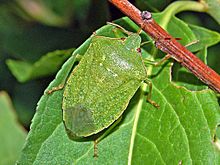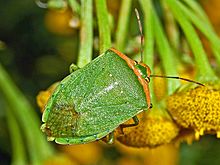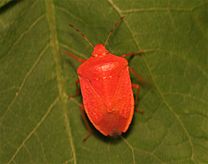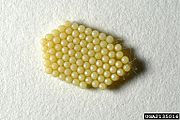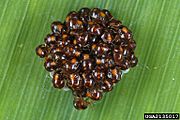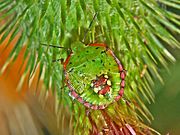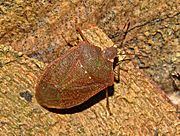Southern green stink bug facts for kids
Quick facts for kids Southern green stink bug |
|
|---|---|
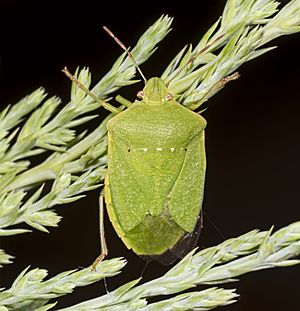 |
|
| Scientific classification | |
| Genus: |
Nezara
|
| Species: |
viridula
|
| Synonyms | |
|
|
The Nezara viridula, often called the southern green stink bug, is a type of insect that eats plants. People in different places call it by other names, like the southern green shield bug (in the UK) or the green vegetable bug (in Australia and New Zealand). This bug is thought to have come from Ethiopia. Now, you can find it all over the world. It likes to eat certain plants, especially legumes such as beans and soybeans. Because it feeds on these important crops, it is considered a pest.
Contents
What Does the Southern Green Stink Bug Look Like?
Adult male stink bugs are about 12.1 millimetres (0.48 in) long. Female stink bugs are a bit bigger, reaching about 13.1 millimetres (0.52 in). Their bodies are usually bright green and shaped like a shield. Their eyes are often reddish, but they can also be black. You can see three white spots in a row on their scutellum, which is a small shield-like part on their back.
These bugs look a lot like the green stink bug (Chinavia hilare). However, you can tell them apart by looking at their scent gland openings. In the southern green stink bug, these openings are short and wide. In the green stink bug, they are narrow and long.
Different Colors of the Stink Bug
Southern green stink bugs can come in a few different colors. These color types are called morphs. The most common type is mostly green. This one is known as Nezara viridula f. smaragdula.
Another type is green but has white or yellowish edges on its head and the part behind its head (the thorax). This is called Nezara viridula f. torquata. A very rare type is completely orange or yellow, and sometimes even pink. This one is known as Nezara viridula f. aurantiaca.
Life Cycle and Reproduction
In warm, tropical areas, the southern green stink bug reproduces all year long. In cooler places, they have a special way to survive winter. They go into a resting state called diapause. During this time, their body color can change from green to brown or reddish-brown. This color change can be reversed later.
When it's time to mate, N. viridula bugs make a special sound. They vibrate a part of their body called a "tymbal" at about 100 Hz. This vibration travels through the plant they are on. It helps other stink bugs on the same plant find each other.
The female bug lays 30 to 130 eggs at one time. She glues these eggs firmly to the bottom of a leaf. The eggs are shaped like tiny barrels and have an opening at the top. The eggs hatch in 5 to 21 days, depending on how warm it is.
From Egg to Adult
When the baby bugs (larvae) hatch, they stay close to the empty eggshells. They don't eat for about three days. After this time, they go through their first moult, which means they shed their outer skin. They moult five times in total before they become adults. Each time they moult, they get bigger. Each stage between moults is called an instar and lasts about a week. The last instar stage, right before they become adults, is a day longer.
In one year, up to four generations of these bugs can grow. In the middle of summer, it can take as little as 35 days for an egg to become an adult bug. Until their third moult, the young bugs stay together in groups on the plant. This grouping might help them share chemical defenses against predators, like ants.
Gallery
How the Stink Bug Lives in Nature
The southern green stink bug is a polyphagous herbivore. This means it can eat many different kinds of plants. It feeds on plants from over 30 different plant families. It eats both monocots (like grasses) and dicots (like beans). It especially likes legumes and prefers to eat plants that are making fruit or pods.
The biggest challenge for these bugs in cooler areas is the cold winter. Between 30% and 80% of bugs that try to survive the winter die. They cannot live in places where the average temperature in mid-winter is below 5 °C. Female bugs are more likely to survive the winter than males. Larger bugs and those that turn reddish-brown also have a better chance.
In recent years, this bug seems to be spreading further north in the northern hemisphere. This might be happening because of global warming. How well the bug survives the winter also depends on whether it goes into its resting state (diapause) at the right time.
Where the Stink Bug Comes From and Lives
The Nezara viridula is a cosmopolitan species. This means it lives all over the world in tropical and subtropical areas. You can find it in the Americas, Africa, Asia, Australia, and Europe, between 45 degrees north and 45 degrees south of the equator.
No one knows exactly where it first came from. However, many believe it started in the Ethiopia region of East Africa. From there, it has spread around the world. This happened because the bugs can fly well, and also because of human trade routes.
See also
 In Spanish: Chinche verde para niños
In Spanish: Chinche verde para niños


